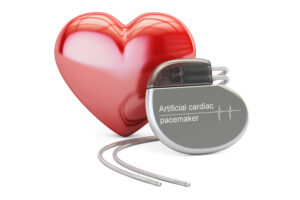Even the most vigilant insurers and reinsurers scanning the risk landscape for potential future liability problems are likely to fall into landmines. What insurance risks of the immediate or distant future are being overlooked now? Here, we highlight risks associated with climate change, tainted consumer products, pandemic-related risks and satellite deepfakes.
1 – Critical infrastructure at risk.
New research by First Street Foundation finds that 25 percent of critical U.S. infrastructure is at risk of flooding today—and that number is expected to increase another 6 percent over the next 30 years.
Additionally, 2.0 million miles of road (25 percent) are at risk today, with that number expected to increase by 3 percent by 2051.
Both residential and commercial property are also at increased risk, the study found. There are currently 12.4 million residential properties (14 percent) at risk of flooding, expected to increase 10 percent over the next 30 years. Meanwhile, 20 percent of commercial properties (918,540) are at risk today, with a 7 percent increase expected.
The study also reveals that the highest concentration of community risk exists in Louisiana, Florida, Kentucky and West Virginia, as 17 of the top 20 most at-risk counties in the U.S. are in these 4 states.
Source: “Infrastructure on the Brink,” First Street Foundation, Oct. 11, 2021
2 – Stress prompting return-to-office lawsuits.
Many employees are being forced to return to the workplace despite requesting accommodations for mental health issues such as anxiety, stress, depression, agoraphobia or PTSD. This has led to a spike in lawsuits, according to a recent report from Bloomberg Law.
Some of these lawsuits “could involve tricky gray areas under the federal Americans with Disabilities Act, such as when leave or telework can be reasonable disability accommodations,” the article says.
ADA claims will be easier to prove for workers with documented pre-existing mental health condition, but Bloomberg said that some pandemic-induced mental health issues could also qualify for accommodations.
While employers can cite an “undue burden” on business operations to deny some accommodations, Bloomberg notes that it will be difficult to raise that defense if employees have been allowed to work remotely for more than a year.
Source: “Pandemic Spike in Anxiety, Stress Prompts Office-Return Suits,” Bloomberg Law, Aug. 19, 2021
3 – Cheeseburger, with a side of phthalates.
Many U.S. fast foods contain industrial chemicals that have been linked to serious health problems, according to a new study published in the Journal of Exposure Science and Environmental Epidemiology.
Researchers at the George Washington University purchased 64 fast food items from different restaurants and asked for three pairs of unused food handling gloves. The team tested food items and the gloves for 11 kinds of phthalates and other plasticizers, finding that:
- 81 percent of the food samples contained a phthalate called DnBP, and 70 percent contained DEHP. Both have been linked to fertility and reproductive problems as well as increased risk for learning, attention and behavioral disorders in childhood.
- 86 percent of the foods contained the replacement plasticizer DEHT, whose impact on human health is still unknown.
- Foods containing meats, such as cheeseburgers and chicken burritos, had higher levels of the chemicals studied. They also had the highest levels of DEHT. The researchers noted that food handling gloves collected from the same restaurants also contained this chemical.
Phthalates and replacement plasticizers are chemicals used to make plastics soft and can migrate out of plastics into the food, which is ingested. Some sources of plastics include food handling gloves, industrial tubing, food conveyor belts and the outer packaging used to wrap fast food meals available in restaurants.
Source: “Potentially harmful industrial chemicals detected in US fast foods,” George Washington University, Oct. 27, 2021; “Phthalate and Novel Plasticizer Concentrations in Food Items from U.S. Fast Food Chains: A Preliminary Analysis,” Journal of Exposure Science and Environmental Epidemiology

4 – AI can create fake satellite imagery.
Geographers from the University of Washington are warning that deepfake satellite imagery could be used to create hoaxes about wildfires or floods or to discredit stories based on real satellite imagery.
Such AI-generated images of cityscapes and countryside might even be a national security issue, as fake satellite imagery could be used to mislead tacticians and mess with mission planning.
The fake satellite images are “uncannily realistic,” said Bo Zhao, lead author of the study published in the journal Cartography and Geographic Information Science. He noted that “untrained eyes would easily consider they are authentic.” And while detection software can spot the fakes based on characteristics like texture, contrast and color, these tools need constant updates to keep up with improvements in deepfake generation.
Source: “Deepfake satellite imagery poses a not-so-distant threat, warn geographers,” The Verge, April 27, 2021; “A growing problem of ‘deepfake geography’: How AI falsifies satellite images,” University of Washington, April 21, 2021
5 – Cyber criminals taking advantage of empty office buildings.
Office buildings across the globe were abandoned when businesses suddenly transitioned to work-from-home amid pandemic lockdowns—and many remain empty, or nearly so. These empty buildings offer myriad opportunities for cyber criminals looking to attack organizations or even feed off their networks, experts warned during a September episode of Insurance Journal’s “Insuring Cyber Podcast.”
Justin Fier, director for cyber intelligence and analytics at cybersecurity technology company Darktrace, said that office buildings emptied during the pandemic can present concerns ranging from something as sophisticated as entrepreneurial criminals setting up bitcoin mining systems in closets that nobody knows about, or something as simple as a criminal walking into a building and plugging into an empty ethernet port.
 The hybrid style most companies seem to be embracing will create new security challenges, he said, noting that his company has found “all sorts of things customers didn’t even realize were on the network…” And then there’s the IoT devices, “like FLIR (thermal imaging) cameras checking the physical temperatures of people when they walk through the security gate to make sure they don’t have a fever or symptoms, or air quality sensors making sure the carbon dioxide levels are within specs with all of the air scrubbers that are happening all over the place.” IoT is still “wildly insecure,” he added.
The hybrid style most companies seem to be embracing will create new security challenges, he said, noting that his company has found “all sorts of things customers didn’t even realize were on the network…” And then there’s the IoT devices, “like FLIR (thermal imaging) cameras checking the physical temperatures of people when they walk through the security gate to make sure they don’t have a fever or symptoms, or air quality sensors making sure the carbon dioxide levels are within specs with all of the air scrubbers that are happening all over the place.” IoT is still “wildly insecure,” he added.
Michael Bahar, litigation partner and co-lead of the global cybersecurity and data privacy practice in Eversheds Sutherland’s Washington, D.C. office, said companies need to be prepared for the worst-case scenario while maintaining the flexibility to quickly adapt to new threats. He warned that, beyond the breach itself, “the worst-case scenario can be the litigation, the regulatory enforcement action, the business interruption and the reputational damage that could come from a breach that was not optimally handled, precisely because it wasn’t well planned for.” He noted, “That is what transforms a bad day into potentially a tragic year or tragic years.”
Source: “Employees May Not Be Working Inside Office Buildings, But Cyber Criminals Are,” Insurance Journal, Oct. 8, 2021
6 – Smartphones and pacemakers don’t mix.
Smartphones and watches can interfere with implanted medical devices, according to a recent study published in Heart Rhythm.
Researchers affiliated with the Center for Devices and Radiological Health (CDRH) at the FDA warn that patients should keep any consumer electronic devices that may create magnetic interference, including cellphones and smart watches, at least six inches away from implanted medical devices. Implantable pacemakers and cardioverter defibrillators include a “magnet mode” designed to be used when a patient is undergoing a procedure where electromagnetic interference is possible or when suspension of the device is necessary for medical treatment. However, this feature can also be triggered accidentally from strong magnetic fields greater than 10G, which can change how the device works and could seriously harm the patient, the researchers say.
The investigators tested the magnetic field output of all iPhone 12 and Apple Watch 6 models at varying distances from the devices. They found that all the devices have static magnetic fields significantly greater than 10G in close proximity. However, when a separation distance of six inches or more is maintained, the phones and watches will not trigger magnet mode.
Source: “New cell phone and smart watch models can interfere with pacemakers and defibrillators,” Elsevier, Aug. 26, 2021; “Static magnetic field measurements of smart phones and watches and applicability to triggering magnet modes in implantable pacemakers and implantable cardioverter-defibrillators,” Heart Rhythm, Aug. 25, 2021
7 – There could be 200 million ‘climate migrants’ by 2050.
Climate change could push more than 200 million people to leave their homes in the next three decades and create migration hotspots unless urgent action is taken to reduce global emissions and bridge the development gap, a World Bank report has found.
The report said the impacts of slow-onset climate change such as water scarcity, decreasing crop productivity and rising sea levels could lead to millions of “climate migrants” by 2050 under three different scenarios with varying degrees of climate action and development.
Under the most pessimistic scenario, with a high level of emissions and unequal development, the report forecasts up to 216 million people moving within their own countries across the six regions analyzed. Those regions are Latin America; North Africa; Sub-Saharan Africa; Eastern Europe and Central Asia; South Asia; and East Asia and the Pacific.
Meanwhile, in the most climate-friendly scenario—with a low level of emissions and inclusive, sustainable development—the number of migrants could be as much as 80 percent lower but still result in the move of 44 million people.
The report didn’t look at climate migration across borders or the short-term impacts of climate change, such as effects on extreme weather events.
Source: “Climate Change Could Force 200 Million People to Abandon Their Homes by 2050,” Associated Press/Carrier Management, Sept. 15, 2021
8 – Fatal infections tied to room spray from Walmart.
A rare bacterial infection that killed two people has been linked to an aromatherapy spray sold at Walmart, according to the CDC.
A total of four people in four states were infected earlier this year by the rare tropical disease melioidosis. A CDC investigation discovered they were exposed to the bacteria by the Better Homes & Gardens Lavender & Chamomile Essential Oil Infused Aromatherapy Room Spray with Gemstones.
The $4 room spray was sold at about 55 Walmart stores and online earlier this year, according to the Consumer Product Safety Commission, which has issued a recall for the approximately 3,900 bottles sold this year.
Source: “Mysterious fatal infections tied to room spray sold at Walmart,” Washington Post, Oct. 22, 2021





















 Rebuilding Negotiation Talent: Why This Skill Is Missing and How to Fix It
Rebuilding Negotiation Talent: Why This Skill Is Missing and How to Fix It  Good Times for U.S. P/C Insurers May Not Last; Auto Challenges Ahead
Good Times for U.S. P/C Insurers May Not Last; Auto Challenges Ahead  Final Sentencing in Large Scale Crop Fraud Case That Cost Insurers Nearly $35M
Final Sentencing in Large Scale Crop Fraud Case That Cost Insurers Nearly $35M  Executives on the Move at Liberty Mutual, Cowbell, W. R. Berkley
Executives on the Move at Liberty Mutual, Cowbell, W. R. Berkley 




